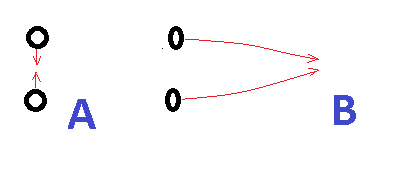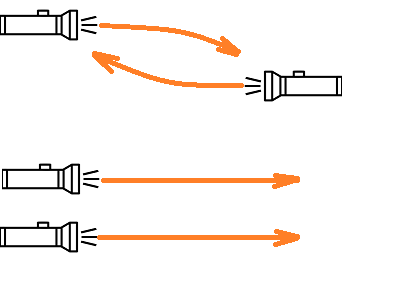Myths of popular physics, continued: Gravity
The first part of the article is here . For the time being, we will examine other myths about which these two guys will not tell you:

Once I had a book on the theory of relativity, released in the USSR. As I remember, there was an illustration drawn: a rocket flies (at near-light speed) and monstrous gravity pulls planets, stars, galaxies towards itself ... All this grows from this formula:

')
Where large M is the “relativistic” mass. This concept was very popular at the beginning of the 20th century, but then Einstein buried him . Actually, up to the factor "tse" the square of this value coincides with the total energy of the body, so it makes no sense to have two different physical quantities that differ only in the factor (and in the "natural" system of units, where c = 1, these quantities are generally identical) . By default, the word “mass” implies a rest mass (more correctly, an invariant mass ).
However, popularizers of science read many early works of physicists - after all, they wanted to describe how it all began. So theydug out the stewardess dragged the relativistic mass into the pages of their books. This, in general, is not so scary, it is only important to understand that this quantity has nothing to do with gravity. Here is an example:

In picture A, we have two balls of the same mass at rest relative to the observer. Due to gravity after a minute the balls are attracted to each other. Now option B - the balls are flying close to the speed of light. Let Lorenz be a factor of 2 (time slowed down by two times, two times shorter, “relativistic mass” is twice as large as the rest mass). How much time will these two balls attract each other?
The problem is solved simply. From the point of view of the observer sitting on the ball, the balls will collide anyway in a minute (the principle of equivalence). But time in the system of balls is slow for an observer who looks at them from the side. This means that it will happen more slowly , and not faster , as many people think (because, say, the relativistic mass has increased)
Not. Here the only thing that can be said is see above.
But this is true. Here it is necessary to dwell on the fact that, in fact, creates gravity:

This is a tensor, a matrix of 4 by 4. Where does the number 4? Three spatial dimensions and one temporal. On the diagonal we have: in the upper left corner, the energy density (for matter, it is easy to think about the rest mass multiplied by the ce-square). Next comes the pressure (in three dimensions). The remaining cells are important for bubbling plasmas with flows close to the speed of light. Heating the body, we increase the pressure inside it (for simplicity, it is better to consider the gas)
It is appropriate to ask an interesting question. But gas pressure is the movement of molecules! That is, instead of a single body with a pressure inside, many individual moving molecules can be considered, and the pressure is zero? Right. Moreover, this can be done even for a “gas” consisting of stars - you can calculate the motion of all the stars individually, and you can say that the galaxy contains a “gas” of stars under a certain pressure. And the result will be the same!
This property of GTR is very helpful: in the coordinate system where the total impulse of the system is zero, we can replace this entire tensor with just a certain mass value (that is, leave one cell) (if we ignore the losses due to gravitational radiation). Thus, we can simply say that a heated body is heavier and not be interested in what is going on inside there. Do you know what it reminds me of from the IT world? Encapsulation !
Everyone knows that light is deflected by the stars. But does the light itself attract other objects? Many believe that it is not, because "the rest mass of the photon is zero." Returning to our tensor, the photon energy is not zero, and they also have an impulse and create pressure — almost all cells are non-zero! A photon gas encased in an ideal mirror shell will create gravity.
Light is attracted to each other, and a black hole can be made from light. Two beams of lanterns directed towards each other will bend, attracting each other. Interestingly, two beams going in the same direction do not interact (you can present this as a limiting case of the first example with balls). In particular, a ray of light cannot “self-focus” due to gravity.

If we have a lot of interacting bodies, then what is the mass of the system? We cannot, as in classical mechanics, take and add up the masses. Observers sitting on different stars will have different opinions about the simultaneity of events, about the mass of different bodies, about the center of mass of the system. The concepts of Komar’s mass (not an insect, but a scientist with that name!) Are developed for a number of particular cases, the ADM mass, the Bondi mass are detailed here . But these are all special cases. In general, it is not clear what mass is in GR. By the way, the concept of “potential energy of a gravitational field” in general also does not exist.
PS
Thanks for the comments on the first part. There were so many of them that I could not physically answer everything. The question was often repeated - here you are saying something, and why you should believe you, this is your word against ours. The purpose of this article is not to prove to you anything, but only to provide you with starting points for googling.

The mass of fast flying bodies increases
Once I had a book on the theory of relativity, released in the USSR. As I remember, there was an illustration drawn: a rocket flies (at near-light speed) and monstrous gravity pulls planets, stars, galaxies towards itself ... All this grows from this formula:

')
Where large M is the “relativistic” mass. This concept was very popular at the beginning of the 20th century, but then Einstein buried him . Actually, up to the factor "tse" the square of this value coincides with the total energy of the body, so it makes no sense to have two different physical quantities that differ only in the factor (and in the "natural" system of units, where c = 1, these quantities are generally identical) . By default, the word “mass” implies a rest mass (more correctly, an invariant mass ).
However, popularizers of science read many early works of physicists - after all, they wanted to describe how it all began. So they

In picture A, we have two balls of the same mass at rest relative to the observer. Due to gravity after a minute the balls are attracted to each other. Now option B - the balls are flying close to the speed of light. Let Lorenz be a factor of 2 (time slowed down by two times, two times shorter, “relativistic mass” is twice as large as the rest mass). How much time will these two balls attract each other?
The problem is solved simply. From the point of view of the observer sitting on the ball, the balls will collide anyway in a minute (the principle of equivalence). But time in the system of balls is slow for an observer who looks at them from the side. This means that it will happen more slowly , and not faster , as many people think (because, say, the relativistic mass has increased)
If the star is accelerated to high speed, then it can become a black hole
Not. Here the only thing that can be said is see above.
If the body is heated, it weighs more.
But this is true. Here it is necessary to dwell on the fact that, in fact, creates gravity:

This is a tensor, a matrix of 4 by 4. Where does the number 4? Three spatial dimensions and one temporal. On the diagonal we have: in the upper left corner, the energy density (for matter, it is easy to think about the rest mass multiplied by the ce-square). Next comes the pressure (in three dimensions). The remaining cells are important for bubbling plasmas with flows close to the speed of light. Heating the body, we increase the pressure inside it (for simplicity, it is better to consider the gas)
It is appropriate to ask an interesting question. But gas pressure is the movement of molecules! That is, instead of a single body with a pressure inside, many individual moving molecules can be considered, and the pressure is zero? Right. Moreover, this can be done even for a “gas” consisting of stars - you can calculate the motion of all the stars individually, and you can say that the galaxy contains a “gas” of stars under a certain pressure. And the result will be the same!
This property of GTR is very helpful: in the coordinate system where the total impulse of the system is zero, we can replace this entire tensor with just a certain mass value (that is, leave one cell) (if we ignore the losses due to gravitational radiation). Thus, we can simply say that a heated body is heavier and not be interested in what is going on inside there. Do you know what it reminds me of from the IT world? Encapsulation !
Does the light attract other objects?
Everyone knows that light is deflected by the stars. But does the light itself attract other objects? Many believe that it is not, because "the rest mass of the photon is zero." Returning to our tensor, the photon energy is not zero, and they also have an impulse and create pressure — almost all cells are non-zero! A photon gas encased in an ideal mirror shell will create gravity.
Light is attracted to each other, and a black hole can be made from light. Two beams of lanterns directed towards each other will bend, attracting each other. Interestingly, two beams going in the same direction do not interact (you can present this as a limiting case of the first example with balls). In particular, a ray of light cannot “self-focus” due to gravity.

But in general, everything is very bad
If we have a lot of interacting bodies, then what is the mass of the system? We cannot, as in classical mechanics, take and add up the masses. Observers sitting on different stars will have different opinions about the simultaneity of events, about the mass of different bodies, about the center of mass of the system. The concepts of Komar’s mass (not an insect, but a scientist with that name!) Are developed for a number of particular cases, the ADM mass, the Bondi mass are detailed here . But these are all special cases. In general, it is not clear what mass is in GR. By the way, the concept of “potential energy of a gravitational field” in general also does not exist.
PS
Thanks for the comments on the first part. There were so many of them that I could not physically answer everything. The question was often repeated - here you are saying something, and why you should believe you, this is your word against ours. The purpose of this article is not to prove to you anything, but only to provide you with starting points for googling.
Source: https://habr.com/ru/post/442810/
All Articles